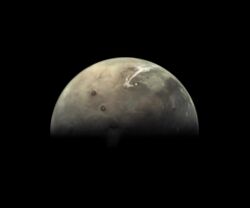Engineering:Visual Monitoring Camera


The Visual Monitoring Camera (VMC),[1] also known as the Video Monitoring Camera[2] and Mars Webcam, is a small camera mounted on Mars Express spacecraft. It is operated by the Mars Express Flight Control Team at ESOC in Darmstadt, Germany.
Starting in 2007, the VMC was used for the Mars Webcam project (sometimes called this after this time) where it takes global views of Mars at a high cadence and they are posted online.[3] The VMC is a camera-on-chip design, using the IRIS-1 system.[3] Originally used as engineering monitoring camera for the Beagle 2 lander, it has a wide 40° field of view and limited imaging controls and it has no focus mechanism.[3] In 2016, it was used for professional science in addition to its roles as a technical monitoring camera and public outreach, etc.[4]
History
The camera was included on the Mars Express mission with the singular goal of monitoring the deployment of the Beagle 2 lander, which occurred on 19 December 2003 at 08:31 UTC. After performing this task, the VMC remained unused, having no intended scientific purpose. In 2007 it was checked out and turned on for educational and science outreach. The Mars Webcam project was born and proved popular with the public, offering wide-angle shots of Mars on a regular basis.[5]
The VMC was adopted as a science instrument in early 2016 in a collaboration between ESA and the University of the Basque Country's Planetary Sciences Group. This collaboration will conduct a two-year study of the images returned by VMC, which provide a global view of the planet and allow for the study of planetary phenomena, including changes in the ice caps, dust storms and cloud activity.[5]
The European Space Agency occasionally establishes campaigns inviting people to propose targets to be imaged by the cameras, such as the event on 25–27 May 2015.[6]
(As of October 2017), more than 21,000 images had been returned.[7] New images are published to the camera's Flickr account in a fully automated process as they are received from the spacecraft,[8] sometimes in as little as 75 minutes from when the photograph was taken at Mars.[7] All images produced by the VMC are released under a Creative Commons Attribution/ShareAlike license (CC BY-SA 3.0 IGO).[9]
In 2018, MW posted pictures of the global Mars dust storm online.[10]
Technical specifications
Specifications of the VMC are:[1]
- CMOS based (IMEC IRIS-1)
- B/W + RGB filters
- Image size: 640×480 pixels
- Pixel depth: 8 bits
- Field of View: 40×31 degrees
- Approximate distance from Mars surface: 300–10,000 km (190–6,210 mi)[11]
- Calculated[n 1] resolution at 300 km: 0.347 km/pixel (0.216 mi/px)
- Calculated[n 2] resolution at 10,000 km: 11.5 km/pixel (7.1 mi/px)
- Mass: 430 g (0.95 lb)
- Size: 65 × 60 × 108 mm (2.6 × 2.4 × 4.3 in)
Observation targets
Noted observations:[12]
- Mars
- Beagle 2
Notes
References
- ↑ 1.0 1.1 "Mars Webcam: FAQ". European Space Agency. http://blogs.esa.int/vmc/faq/.
- ↑ Gimenez, A.; Lebreton, J-P.; Svedhem, H.; Tauber, J. (February 2002). "Studies on the Re-use of the Mars Express Platform". ESA Bulletin (109). http://www.esa.int/esapub/bulletin/bullet109/chapter9_bul109.pdf.
- ↑ 3.0 3.1 3.2 "Mars Webcam: About". European Space Agency. http://blogs.esa.int/vmc/about-the-mars-webcam/.
- ↑ "Mars Webcam goes pro". European Space Agency. 25 May 2016. http://esa.int/Our_Activities/Operations/Mars_Webcam_goes_pro.
- ↑ 5.0 5.1 "Mars Webcam goes pro". European Space Agency. 25 May 2016. http://www.esa.int/Our_Activities/Operations/Mars_Webcam_goes_pro. Retrieved 10 November 2016.
- ↑ "Have you ever used a camera on board an interplanetary craft?". European Space Agency. 6 March 2015. http://www.esa.int/Our_Activities/Operations/Have_you_ever_used_a_camera_on_board_an_interplanetary_craft. Retrieved 10 November 2016.
- ↑ 7.0 7.1 Sánchez-Lavega, Agustin; Titov, Dmitri; Bauer, Markus (17 October 2017). "Webcam on Mars Express surveys high-altitude clouds". European Space Agency. https://www.esa.int/Our_Activities/Space_Science/Mars_Express/Webcam_on_Mars_Express_surveys_high-altitude_clouds. Retrieved 28 July 2018.
- ↑ Lakdawalla, Emily (19 December 2012). "Mars Express VMC resumes raw data posting". The Planetary Society. http://www.planetary.org/blogs/emily-lakdawalla/2012/12190600-mars-express-vmc.html. Retrieved 10 November 2016.
- ↑ "VMC The Mars Webcam". Flickr.com. https://www.flickr.com/people/esa_marswebcam/. Retrieved 10 November 2016.
- ↑ [1]
- ↑ Clark, Stephen (25 December 2003). "Mars Express a success, but no one hears Beagle's bark". Spaceflight Now. https://www.spaceflightnow.com/mars/marsexpress/031225update.html. Retrieved 10 November 2016.
- ↑ [2]
External links
- Mars Webcam Photostream at Flickr.com
- Mars Webcam Blog by the European Space Agency
- An ordinary camera in an extraordinary location: Outreach with the Mars Webcam

